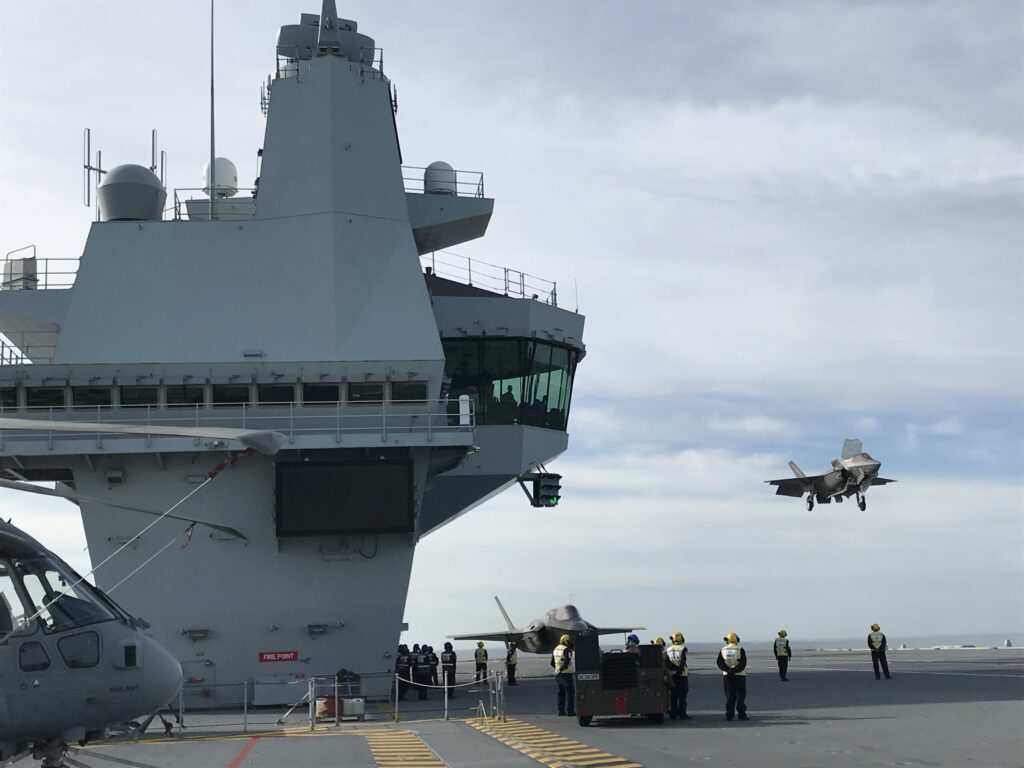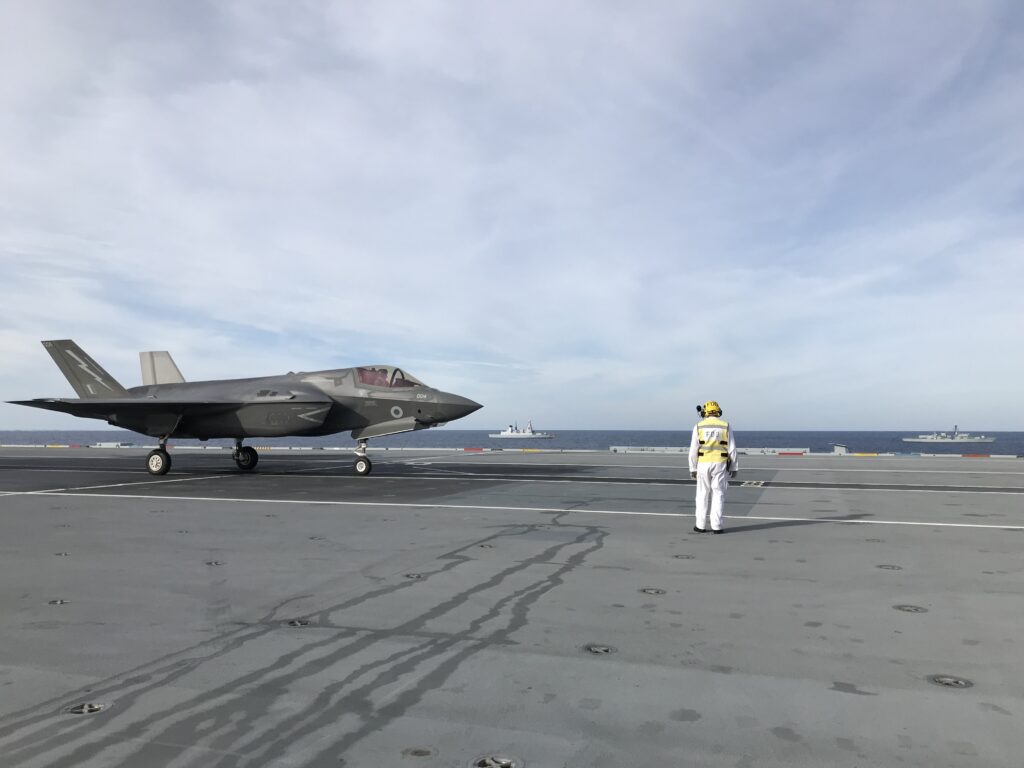
The Royal Navy makes one of its first VTOL landings aboard its new aircraft carrier. Pic: Paul McLeary)
ABOARD HMS QUEEN ELIZABETH: For the first time, a US Marine Corps F-35B squadron will deploy aboard the UKs new aircraft carrier on its maiden voyage in 2021, a milestone hailed as “unprecedented” — even among close allies.
“We’re not talking about interoperability anymore; we’re talking about proper integration to a level we’ve never seen,” British Fleet Commander Vice Adm. Jerry Kyd told me on the deck of the carrier as it launched and recovered aircraft during an exercise in the Atlantic.
The integration of Marines into the British carrier’s operations from Day One is “unprecedented,” he said. “It would be hard to think of another two countries on the planet who can do that right now.”
As Kyd and fellow Royal Navy officers praised the “special relationship” between Washington and London during a recent visit to the ship, the US Navy’s top admiral was half a world away, using much the same language to pitch his own ideas for closer linkages between allied navies.
“Today, the very nature of our operating environment requires shared common values and a collective approach to maritime security,” Chief of Naval Operations, Adm. Mike Gilday, told a seapower conference in Venice.
Gilday alluded to the British upgrades and increasing operations with NATO allies at sea, noting that Adm. Mike Mullen, former Navy chief, once talked about a 1,000-ship Navy. “I say, why not a 10,000-ship navy? With like-minded partners, there’s a lot we can do together to keep the maritime commons free and open.”
Spurring the move toward greater linkages between allied forces are the realities of a more aggressive and rapidly modernizing Chinese navy, and an increasingly unpredictable Russia. “We are defending international norms to foster global economic prosperity; we do it to protect the right to navigate the world’s international waters; we do it to ensure smaller nations are not bullied by others,” Gilday said in Venice.
Similarly, Kyd sees the increasing integration as an obvious move in an era punctuated by a variety of potential threats. “Why wouldn’t we be far more integrated with our key ally at a moment where the rules-based international system is under threat, and we need to reinforce our western values and operate together?”
Kyd, who commanded the Queen Elizabeth last fall when she ran weeks of trials off the US east Coast, is now responsible for overseeing all operational elements of the Royal Navy. Last year’s deployment saw the Brits flying US-based F-35s, but just this past week Royal Navy pilots began flying their own F-35Bs from the ship, becoming the first non-US pilots to own and fly carrier-based Joint Strike Fighters.
The QE is joined on this trip by the newly-formed Westlant 19 Carrier Strike Group – comprised of Type 45 destroyer HMS Dragon, submarine hunter HMS Northumberland and tanker RFA Tideforce.
“We are learning how to fight a carrier strike group beyond the jets for the first time,” Commodore Michael Utley told me. The new ship, flying new aircraft, “is a huge step forward. It’s not just a return,” to carrier operations, he said.

F-35 with Westlant 19 Carrier Strike Group’s Type 45 destroyer HMS Dragon and sub hunter HMS Northumberland.
The QE has been working up to its 2021 deployment to the Mediterranean and Middle East in the waters along the US East Coast since July, readying for the Royal Navy’s first carrier operations in a decade.
The new carrier has been specifically designed to operate the F-35, and British officers on board refer to it as a “5th generation” ship that represents a massive leap over the Invincible-class big decks the Royal Navy retired in 2010, leaving the country — which has one of the proudest naval traditions in the world — without a carrier.
“This aircraft carrier for the UK is strategic, not just in terms of scale — she’s the biggest carrier we’ve ever had — but she’s interoperable with the US Marine Corps and again it’s that trust. You can’t surge trust,” Kyd said.
That integration with the Marines comes as the Corps and the Navy are working on a new force structure assessment due later this year aimed at more closely linking the operations of the two. It’s a major shift for the Corps, which is coming off almost two decades of operating primarily as a ground force in the Middle East. As part of the emerging shift back to the sea, the Marines are looking to begin testing unmanned platforms to quickly refuel and rearm their F-35Bs operating from remote, austere bases in the Pacific — part of an effort to be more nimble and unpredictable, as the traditional American dominance at sea and in the air erodes.
Last month, Marine leaders announced a year-long round of war games to push the force into the future, while Gilday and Marine Commandant Gen. David Berger recently signed a memo pledging to work on a joint project to hack out a new way to project power forward. The goal is to more closely align their doctrine, training, and equipping plans to complement one another, rather than the Navy simply providing lift and cover for the Corps.
And now, with the QE preparing to set sail, it appears the Royal Navy may play a key part in those plans.
With the QE in the fleet, “we’ve jumped into a much more sophisticated networked environment, and together [with the US] there’s huge potential in the next 4 to 5 years to really squeeze out the maximum from this very advanced aircraft that we couldn’t even think about 10 years ago,” Kyd said.
The Royal Navy’s second F-35-specific carrier, HMS Prince of Wales, is currently undergoing sea trials in the North Sea in preparation for its planned first deployment in 2023. Having two brand-new carriers that can swap aircraft and missions with the US Navy and Marine Corps is, by any measure, a significant move at a time when US East Coast-based carriers are having some trouble making it out to sea on schedule.
Textron, Leonardo bank on M-346 global experience in looming race for Navy trainer
“The strength we think we bring is that [the Navy is] going to go from contract to actually starting to turn out students much quicker than any other competitors,” a Textron executive told Breaking Defense.


























